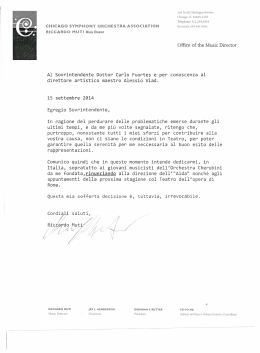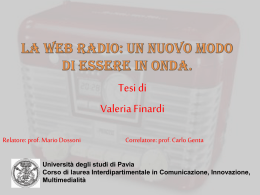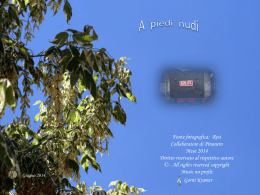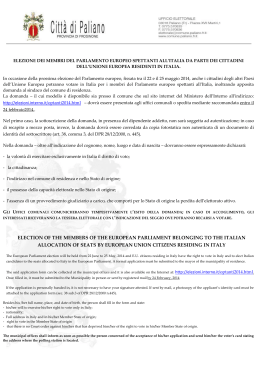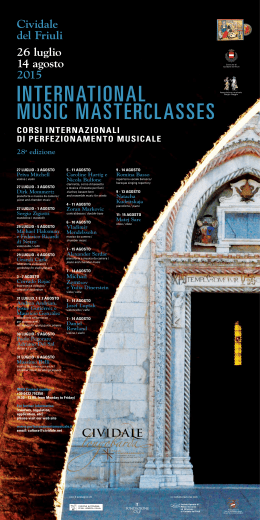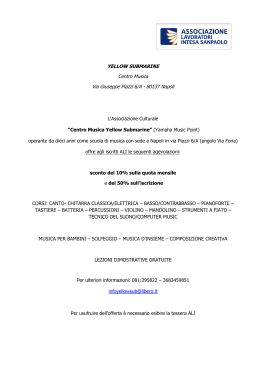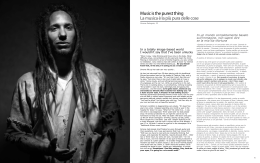T AFELMUSIK Traditional (Campania) Gian Carlo Gailò Vulumbrella Sonata for 3 violins & continuo 1659–1722 Largo assai–Allegro e non presto–Allegro October 11–14, 2012 at Trinity-St. Paul’s Centre Traditional (Apulia) Soni a battenti Giovanni Battista Pergolesi Sinfonia & Aria “Chi disse ca la 1710–1736 femmena,” from Lo frate ‘nnamorato Bella Napoli With special guests Vesuvius Ensemble Concerto grosso no. 5 in D Minor Alessandro Scarlatti 1660–1725 Allegro – Grave – Allegro – Minuet Improvised Traditional (Salento, Apulia) Traditional (Procida, Campania) Fronna Pizzica tarantata Madonna delle grazie Leonardo Leo Concerto for cello in A Major Francesco Durante Concerto grosso no. 5 in A Major 1684-1755 Presto – Largo – Allegro Athanasius Kircher/Anon Traditional (Apulia) Tarantella medley La Pizzica dii San Vito dei Normanni Vesuvius Ensemble Francesco Pellegrino, tenor & chitarra battente Marco Cera, baroque guitar & ciaramella Lucas Harris, theorbo with Ben Grossman, percussion 1694–1744 Andantino grazioso – Allegro – Larghetto – Allegro Christina Mahler, violoncello Traditional (Apulia) Tu bella Leonardo Vinci “Vurria addiventare suricillo” 1696–1730 from Li zite ‘n galera Traditional (Campania) Lu Guarracino INTERMISSION TA F E L M U S I K BA RO QU E O R C H E S T R A Jeanne Lamon Music Director Violin I: Violin II: Viola: Violoncello: Double Bass: Harpsichord: Jeanne Lamon, Thomas Georgi, Christopher Verrette, Cristina Zacharias Julia Wedman, Patricia Ahern, Geneviève Gilardeau Patrick G. Jordan, Renate Falkner Christina Mahler*, Allen Whear Alison Mackay Charlotte Nediger * Cello chair generously endowed by the Horst Dantz and Don Quick Fund n 12 13 n VESUVIUS ENSEMBLE Vesuvius Ensemble is a new Torontobased trio dedicated to the musical and cultural heritage from Naples and surrounding areas of southern Italy. The ensemble performs songs in dialect from the Italian countryside which have been passed on orally and in writing over centuries and finally researched and recorded in the twentieth century. The songs are accompanied by baroque continuo instruments (baroque guitars, chitarrone) in combination with rustic string, percussion, and wind instruments typical of the region (chitarra battente, colascione, tammorra, ciaramella). The ensemble is led by tenor Francesco Pellegrino. Though a classically trained singer, Pellegrino also possesses rare first-hand experience with the traditional folk music of southern Italy, and formed Vesuvius Ensemble as a North American vehicle for its performance and preservation. Joining him are the versatile musicians oboist/guitarist Marco Cera and lutenist Lucas Harris, and the ensemble is fortunate to have the multitalented percussionist Ben Grossman as a frequent collaborator. Vesuvius Ensemble is pleased to be performing this season at the Midland Festival, on the Ponticello series in Ottawa, at McMaster University, and at the University of Toronto. Italian tenor Francesco Pellegrino has been a celebrated singer of traditional and classical Neapolitan music since his childhood. Formal studies at the Benevento Conservatory, L’Accademia di Canto Verdiano di Bussetto (Parma) and L’Accademia Chigiana di Musica (Siena) led to a career on the opera stage. He sang in the chorus of Milan’s Teatro alla Scala 1997–2001, and has interpreted the roles of Cavaradossi (Tosca), Pinkerton (Butterfly), Il Duca (Rigoletto) and Alfredo (Traviata). On the concert stage he has performed sacred works by Mozart, Beethoven, Rossini,Verdi and Bruckner. Francesco currently makes his home in Toronto, Canada, where he is an instructor of Italian art song in Voice Studies at the University of Toronto. Italian oboist Marco Cera studied at the Padua Conservatory of Music and at the Musikhochschule der Stadt Basel. He regularly collaborates with the leading baroque orchestras in Italy and Europe, and in 2007 moved to Toronto to join Tafelmusik. Marco has been interested in ethnic music since his teenage years. Among the popular instruments he has collected and learned to play is the ciaramella, a sort of early oboe that he first heard played by Italian shepherds at Christmas. As a guitarist Marco is a member of Ensemble Polaris, Canada’s premiere Arctic Fusion band. n 14 Lucas Harris studied early music in Milan and Bremen before establishing a busy performing career as a lutenist, based first in NewYork and then in Toronto. He is a founding member of a handful of Toronto enterprises: the “pluck-band” called the Toronto Continuo Collective, the summer chamber music series Beaches Baroque, the Vesuvius Ensemble, and the multi-ethnic Lute Legends Ensemble. Lucas is pursuing graduate studies in conducting at the University of Toronto, and has been a guest director with Pacific Baroque Orchestra and Ohio State University Opera Program. He recently released the CD The Bach-Weiss Sonata with his wife, Tafelmusik violinist Geneviève Gilardeau. Ben Grossman is a busy musician: improviser, studio musician, composer, noisemaker and audio provocateur. He works in many fields, having played on dozens of CDs, soundtracks for film and television, sound design for theatre, installations, work designed for radio transmission, and live performances spanning early medieval music to experimental electronica. With an abiding interest in pushing the limits of his instruments and pushing the boundaries of whatever venue or medium in which he works, Ben’s solo CD, Macrophone, was released in 2007 and features a unique two-disc form for simultaneous, aleatoric playback. T E X T S & T R A N S L AT I O N S Fronna Improvised text Pizzica Tarantata Addó t’ha pizzicato la tarantella sott’a la puttarria di la vunnella da se vasa nu cardillo e na palomma? Te preu San Paulo falla guarire da l’avea pizzicato la tarantella. Oj, vej-li-vuej li-voje-là, bello è l’amore e ci lu sape fà. Ci nun lu sape fà, cunfidenza nun ni dà. Ca ci ste la mamma ca ci penza. La figghia di la massara s’è ’mparatu le jaddinaru, s’è ’mparatu lu pertusu edda sotta e ju susa. Si non ci tu ni vai da ccà quanta cose c’agghia fà. T’agghia scascia lu cantaro e addò diavulo a tà cacà. Addò t’ha pizzicato pozz’esse accisa, sott’a la puttarria di la cammisa. Ci è taranta lassala ballarì. Ci è malincunia, cacciala fora. Where did the tarantula sting you? Was it beneath your underskirt, where the goldfinch and the dove kiss? I beg you, St. Paul, to heal her, for she’s been bitten by the tarantula. Oh, vej-li-vuej li-voje-là, love is beautiful and so are those who know its ways. And for those who don’t know, have confidence: Mama is here and she’ll take care of it! The landlady’s daughter has learned how to garden, she has learned the little hole: her below and me on top. Ah, I’ll do so many things to you if you don’t leave here! I’ll break your bedpan, and then where the devil will you do your business? Where did he sting you, beneath your undershirt? If you’ve been bitten, then dance! If you’re melancholy, chase it away! 15 n Madonna delle Grazie Regina de lu cielo, o Divina maestà, chesta grazia ca te cerco fammella pe’ pietà. Madonna de la grazia ca ‘mbraccio puorte grazia a vuje vengo pe’ grazia o Maria fance grazia. Fance grazia o Maria comme te fece lu Pateterno ca te fece mamma de Dio fance grazia o Maria. Fammella o Maria fammella pe’ carità pe’ li done ca riceviste dalla Santissima Trinità. Scese l’angelo da lu cielo e te venne a salutà, salutà venne a Maria e nuie cantammo l’Avemmaria … Queen of the heavens, oh divine majesty, this grace I’m asking from you — give it to me for pity’s sake! Our lady of grace who carries grace in her arms, I ask you for a blessing — oh Mary, give us grace! Give us a blessing, oh Mary, as the eternal father did for you. He made you the mother of God — give us a blessing, oh Mary! Give it to me, oh Mary, give it to me for heaven’s sake, for the gifts you received from the Holy Trinity. An angel descended from heaven and came to greet you, he came to greet Maria and now we sing the Ave Maria … Tu bella Tu bella ca lu tieni lu pettu tundu nun sacciu ci su menne o su cutugna. You, beauty, with your round bosom, I’m not sure if they are breasts or quinces. Maria ti chiammi tu, ci bellu nommi stu nommi ti l’ha mmisu la Madonna. Your name is Mary, such a pretty name — it was given to you by the Madonna. Stateve cite, statevi ‘nzulenzia, vogghiu ca vuje sintiti lu mia cantare. Hush, be quiet — I want you all to hear my song. Bellu è lu mare e bella la marina, bella è la figlia di lu marinaru. The sea and the shore are beautiful, as is the sailor’s daughter. La ni la ninina la ni ninena, ha dettu l’amuri miu staseri vena. La ni la ninina la ni ninena, my love told me she would come tonight. Marange e marangelle vogghiu chiantari nu limoncellu pi lu beni mia. I’ll plant oranges and tangerines, a lemon tree for my love. Bella dintr’a li belle tu bella sei, ca de li belle tu puorti la palma You are the fairest of the fair, the prize for beauty goes to you. Tu rondine ca rundini lu mare, ferma quandu ti dicu doje parole. Oh swallow skimming over the sea, stop, so I can say a couple of words to you! n 16 Vorria addeventare sorecillo Vorria addeventare sorecillo pe mettere paur’a a la sia Annella, le vorria dà ’no muorzo a lo pedillo, e straccià la podea de la gonnella. E po’, pecché so’ tanto peccerillo mme vurria abbuscà ’na moglierella ca veco ’nzurà’ ’a chisto e ’nzurà’ ’a chillo e pe’ me nun ce sta ‘na moglierella. E ba’, e ste breccia, che puorte ’mpietto tu le puorte pe mme sciaccà. I wish I could turn into a little mouse so as to frighten Signora Annella. I would like to bite her little foot and tear off the hem of her skirt. And then, since I am just a young man, I would like to find myself a little wife. For I see this guy and that guy getting married, but for me there is no little wife. Yes, indeed, and the jewels you have around your neck — you wear them just to torment me. Lu Guarracino Lu Guarracino che jeva pe’ mare lle venne voglia de se ‘nzorare: se facette nu bello vestito de scarede de spine pulito pulito co na perrucca tutta ‘ngrifata de ziarelle ‘mbrasciolata. Co lo sciabò de scolla e puzine de ponta angrese fine fine. The Guarracino [damselfish] faring through the sea was taken by the wish of getting married. He made himself a beautiful suit of scale and fish bone nice and clean with a wig all entwined with rolled up ribbons, with jabot, neck and cuffs of fine English embroidery. Ddoje belle cateniglie de premmone de conchiglie, no cappiello aggallonato de codarino d’aluzzo salato tutto posema e steratiello, jeva facenno lo sbafantiello, gerava da ccà e da llà la ‘nnammorata pe’ se trovà. Two fine chains of seashell lungs, a hat, ornamented with salted pike tails. All primped and tarted up he went, showing off, cruising here and there looking for a sweetheart. La sardella allo barcone steva sonanno lo calascione, e a suono de trommetta jeva cantanno st’arietta: “E llarè lo mare e lena e la figlia d’a si’ Lena ha lassato lo ‘nnammorato pecchè niente l’ha rialato.” The sardine on her balcony was playing the colascione and with a trumpeting sound was singing this song: “E llarè lo mare e lena and the daughter of signora Lena left her suitor for he’s not given her any sort of gift.” Lo Guarracinop ‘nche la guardaje de la sardella s’annammoraje, se ne jette da na vavosa la cchiù vecchia maleziosa, l’ebbe bona rialata The Guarracino looked at the sardine and fell right in love. He went to a vavosa [another kind of fish], the oldest and shrewdest, and gave her a nice bribe 17 n pe’ mannarle la ‘mmasciata, la vavosa pisse pisse chiatto e tunno ‘nce li disse. to deliver his message. The vavosa psst psst told her loud and clear: Si aje voglia de t’allocà tanta smorfie non aje da fa, fora le zeze e fora de scuorno anema a e core e faccia de cuorno.’ Ciò sentenno la si’ sardella s’affacciaje a la fenestella fece n’uocchio a zennariello a lo speruto ’nnammuratiello. “If you wish to find a husband you mustn’t be so surly. Stop all this coyness and bashfulness: tough spirit, heart and face!” Hearing this, the sardine showed herself at the window and made eyes at her timid suitor. Ma la patella che steva de posta la chiammaje faccia tosta, senza parola, male nata, ch’avea ‘nchiantato l’alletterato primmo e antico ’nnammorato, de carrera da chisto jette, e ogne cosa le dicette. But the watchful limpet nearby then called her shameless, a betrayer and scoundrel, for she had left the little tuna fish, her first and former suitor. The limpet rushed to him and told him everything. Quanno lo ‘ntise lo poveriello, se lo pigliaje farfariello, jette a la casa, s’armaje a rasulose carrecaje comm’ a nu mulo de scoppette e de spingarde, povere, palle, stoppa e scarde, quattro pistole e tre bajonette dint’ a la sacca se mettette. When the poor thing heard this story, the devil made him go berserk. He rushed home and armed himself up to his ears: he loaded himself like a mule with guns and muskets, gunpowder, balls, hemp and flint; four pistols and three bayonets he put in his pocket. ’Ncoppa a li spalle sittanta pistune, ottanta bomme e novanta cannune, e comm’ a guappo pallarino jeva trovanno lo Guarracino, la disgrazia a chisto portaje che ’nmiezo a la chiazza te lo ’ncontraje se l’afferra p’ o cravattino po’ lle dice “ah malandrino! Upon his shoulders he had 70 guns, 80 bombs and 90 cannons, and like a brave paladin went looking for the Guarracino. Bad luck would have it that he met him in the middle of the square: he grabbed him by his little necktie and said to him, “You scoundrel! tu mme lieve la ’nnammorata e pigliatella sta mazziata” Tuffete taffete a miliunelle deva pacchere e secazzune, schiaffe, ponie e perepesse, scoppolune, fecosse e connesse, scerevecchiune e sicutennosse e l’ammacca osse e pilosse. So, you’re taking my beloved away from me? Then take this beating!” He hit him with millions of blows: slaps and punches, smacks, wallops, and thwacks, beatings, trouncings, thumps to the neck, cuffs and shouts, bruising his bones and cartilage. n 18 Venimmoncenne ch’ a lo rommore pariente e amice ascettera fore, chi co’ mazze, cortielle e cortelle, chi co’ spate spatune e spatelle, chiste co’ barre, chille co’ spite, chi co’ ammennole e chi co’ antrite, chi co’ tenaglie e chi co’ martielle, chi co’ torrone e sosamielle. Then it happened that upon hearing this noise relatives and friends came out, some with clubs and knives some with daggers, some with swords, some with bars, some with spears, some with almonds and others with hazelnuts, some with pliers and others with hammers, some with nougats and others with sesame sweets. Patre, figlie, marite e mogliere s’azzuffajeno comm’ a fere. A meliune correvano a strisce de sto partito e de chille li pisce. Che bediste de sarde e d’alose! de palaje e raje petrose! Sarache, dientece ed achiate, scurme, tunne e alletterate! Fathers, daughters, husbands, and wives fighting like wild beasts! By the millions raced bands of fish from the one or the other mob. You should have seen all those sardines and shads! How many soles and thornback rays! Bass, snappers, sea breams, mackerels, big and little tuna fish! Capitune sàure e anguille, pisce gruosse e piccerille, d’ogne ceto e nazione, tantille, tante, cchiù tante e tantone! Quanta botte, mamma mia! Che se dèvano, arrassosia! A centenare le barrate! A meliune le petrate! Giant eels, horse-mackerels, sea snakes, small and large fish of every class and nation from the smallest to the most gigantic! How many blows, mamma mia, they gave one another — heaven help us! Stick knocks by the hundred! Stone bashings by the million! Ma de cantà so già stracquato, e me manca mò lo sciato, sicchè dateme licenzia, graziosa e bella audienzia, ’nfì che sorchio na meza de seje, co’ salute de luje e de leje, ca se secca lu cannarone sbacantànnose lo premmone. But now I am tired of singing and I’m getting short of breath, So please give me leave, gracious and handsome audience So that I can slosh down a measure to her and his health, for the throat gets dry as the lungs get empty! Vulumbrella Fatte molla e no cchiù ddura mò ca si’ formosa e bella ca ogne fica vulumbrella a ‘sto tiempo s’ammatura. Now let your hardness be softened, now when you are so young and beautiful, for every honey fig ripens during this season. Fatte doce e no cchiù amara nun te fatenere acerba e non esser tanto brava fatte umile e no superba. Be sweet and no longer tart, don’t let yourself be picked while you’re still bitter, and don’t be too greedy — be humble and not proud. 19 n Mò ca è verde la toja erba e lu munno renovella ca ogne fica vulumbrella a ‘sto tiempo s’ammatura. While you are still maturing, let the world remember that every honey fig ripens during this season. Mò ca sì ‘mmeza ammullata e tra fionne fai la guerra nun aspettare ca si’ seccata e che cade in chiana terra. Now that you are ripe and ready for life among the leaves don’t wait, or you’ll dry up and fall to the soft earth. Fa’ ca’ ppo’ da te se sferra ca si’ tosta fredda e bella ca ogne fica vulumbrella a ‘sto tiempo s’ammatura. Let all of the cold and distant hardness leave you now, for every honey fig ripens during this season. Soni a battenti … a battenti Sona chitarra mia soni a battenti. Li colpi giusti lu sunatore ti dà. … a battenti [ = ‘in a percussive fashion’] My guitar plays, plays a battenti – the player gives you just the right kind of strumming. Ruspiti da lu sonnu no cchiù dormire ca non ci dormi quannu ce avimmu amari. Wake up from your slumber, don’t sleep anymore! You cannot sleep when you must love instead. Nu lettu di viole ci lu faciti. Li materazzi e li cuscini di seta. Li lenzoli sono arrecamati. A bed of violets you’ll make for it, mattresses and silk pillows; the sheets are embroidered. Li cuperti soni di vasilicoj. L’occhio toi belli so li fronni d’arburelli e l’occhi toi vivaci so li fronni di vammacia. The blankets are made of basil; Your beautiful eyes are like the leaves on little trees, and your vivacious eyes are like balls of cotton. Rapilu, bella, ca t’avi da parlà t’ava dicere duje paroli tienele a mente non li scurdà. Open them, my beautiful one, for I must speak to you, I must tell you a couple of words: keep them in your mind and do not forget them! n 20 Chi disse ca la femmena Chi disse ca la femmena sa cchiù de Farfariello disse la veretà. Whoever says that women are smarter than the devil is telling the truth. Una te fa la nzémprece ed è malzeosa. Nautra fa la schefosa e bo’ lo maretiello chi cchillo tene ‘n core e a chisto fegne ammore; e lo sta a reppassa’. Nce sta quaccuna po’ che a nullo vole bene, e cciento ‘n frisco tene schitto pe scorcoglia’. E tant’aute mmalizie chi maie le ppo’ conta’? One pretends to be simple but then becomes evil. another acts all fussy, wanting a young man, holds him close to her heart, and then she pretends to love him and constantly flirts with him. And yet another one who loves nobody at all yet keeps a hundred close by, though she is always ready to abandon them. And so many other evils that nobody could recount them all. Chi disse ca la femmena … Whoever says that women … La Pizzica di San Vito Non c’era da venì e so’ venuto so li sospiri tua m’hanno chiamato. Ahi, core de zuccaru e limone, t’agghia dà nu vasu a mocca m’agghia zuccherà la vocca. I should not have come here, but I’m here now, I know that your sighs have called me. Ah, heart of sugar but also of lemon, I must kiss you in order to sweeten my mouth. E si chiu bella tu de na cirasa iata a l’amore tua quannu te vasa. Ah, uellì uellì uellà, tu bedda di stu cori tu di me non ti scurdà. You are lovelier than a cherry; blessed be your love when I kiss you. Ah, uellì uellì uellà, beauty, you won’t forget about this heart of mine. Di li capelli tua so ’nnamurato, li veco di vulà d’intra lu viento. Ah, uellì uellì uellà I’m in love with your hair, I see it flying in the wind. Ah, uellì uellì uellà E vulia cu te la dau lu core miu no me nde curu ca io senza vau na na na na na na na beddhu l’amore e ci lu sape fa. And I would like to give you my heart, I don’t care if I have to leave without it. Na na na na na na na, love is beautiful and so are those who know its ways. Translations prepared by Lucas Harris with generous help from Guillaume Bernardi, Nancy Canepa, Ivo Magherini, and Francesco Pellegrino. 21 n P RO G R A M M E N OT E S by Lucas Harris The Singing City of Naples The singing siren Parthenope has long been an important symbol of Naples, a city which some considered the musical capital of Europe during the baroque era. In the mythology of the ancient Greeks who founded the city, Parthenope died of a broken heart after failing to enchant Ulysses with her song. She threw herself into the sea, and her body washed up on the shore where the city now stands. Since then, the Bay of Naples has been known as a safe harbour to anybody who comes ashore there, especially if they have fallen victim to misfortune. Misfortune was something that the people of Naples in the sixteenth and seventeenth centuries knew about. The city was an important strategic point in wars waged by European powers, and was under the control first of the Spanish Hapsburgs, then the Austrian Hapsburgs (1707–1734), then the Spanish Bourbons. The city was attacked several times by the French. Frequent famine and political unrest led to the Masaniello uprising of 1647 and other riots. Add to this the natural calamities which befell the city: after 131 years of dormancy, Mount Vesuvius had a colossal eruption in 1631, and continued to have other severe eruptions in 1660, 1682, 1694, 1698, 1707, and 1737. Massive earthquakes also shook the city at regular intervals. But perhaps the worst calamity of all was a devastating outbreak of the plague in 1656 that reduced Naples’s population from about 360,000 to 160,000. In spite of all these disasters, Naples was experiencing a sort of “Golden Age” in her history. She had become the second-largest urban center in Europe (next to Paris), and she was an important and well-defended port of the Spanish Empire. A construction boom was putting up new churches, a new Royal Palace, public buildings, public theatres, and opera houses, in addition to beautiful villas for the Spanish viceroys. Naples was seen as an important cultural center, and Neapolitans were making important contributions in the fields of art, literature, philosophy, theatre, and of course, music. A large part of Naples’s reputation for excellence in music was the presence of her four conservatories: S. Maria di Loreto, S Onofrio a Capuana, Pietà dei Turchini, and Poveri di Gesù Christo. The music pupils in these former orphanages did not enjoy ideal conditions: they were always cramped for rehearsal/practice space, and were sometimes cold and even hungry.Yet these conservatories offered a complete education in music with Naples’s best musicians, and so they attracted students from all over Italy. Unlike the young women from Vivaldi’s Pietà in Venice, whose musicmaking was usually confined to the orphanage, the boys of the Naples conservatories n 22 frequently put on their coloured uniforms and participated in musical events in Naples’s festivals and churches. In doing this they gained professional experience and also generated income for the schools.The castrati brought in the most revenue, and so they were given better housing, food, and instruction than the other pupils. In the context of a concert it is impossible to do more than scratch the surface of the complete breadth of Naples’s musical activity. (One huge category of music we’re not able to represent well with our forces is the glorious sacred music written for Naples’s churches, which numbered more than 500.) The goal of our programme is to juxtapose art music with folk music, and to explore a few points where they intersected at the time, and where they can be “coaxed into” a point of intersection today, for example in our string orchestrations of some of the folk songs. It should be made clear that not all the music is from the actual city of Naples: the folk songs presented by the Vesuvius Ensemble come from various zones within the southern Italian regions of Campania and Apulia, most of them probably dating from the baroque period or earlier.The songs were passed down orally for centuries and finally documented by researchers such as Alan Lomax and Diego Carpitelli in the years following World War II, just as television and mass media were beginning to erode local traditions and dialects. One of the repertoire’s most important champions was Roberto De Simone, the pianist-composer-musicologist-stage director who formed an ensemble called Nuova Compagnia di Canto Popolare. NCCP was active in the 1970s, releasing many vinyl recordings that helped a generation of southern Italians to rediscover their musical roots. The Vesuvius Ensemble uses a handful of rustic instruments that are still typical of the southern regions today, though not commonly seen on concert stages: Chitarra battente: a rustic adaptation of the baroque guitar originating in the eighteenth century. Rather than gut strings and frets, it is strung with metal strings and fitted with fixed metal frets. Mandolino: the Neapolitan type of mandolin, tuned like a violin with doublestrung courses of metal strings. On both this instrument and the chitarra battente, the metal strings are stretched over a movable bridge which sits upon a canted soundboard. Ciaramella: a type of traditional Italian shawm (early oboe), closely related to the zampogne (Italian bagpipes). Colascione: a long-necked lute having two or three courses of strings and played with a plectrum, commonly pictured with commedia dell’arte characters such as Pulcinella. This performance substitutes a very close cousin, the Turkish saz. 23 n Tammorra: a large frame drum, often with cymbals attached to the sides. Tamburello: a type of tambourine, also with cymbals, but smaller than the tammorra. One of the most important themes in this folk repertoire is music used for ritual. The fronna is a sort of improvised vocal lament which is performed a cappella and is related to traditional funeral laments from rural areas.“Maria delle Grazie” points to the intense devotion to the Virgin found in Campania. Each year on the island of Procida, this song is sung one hundred times on August 15th in an exuberant crescendo of mystical devotion.The many Southern festivals and rituals devoted to Mary may actually represent a Christian reworking of pagan practices: the ancient Greek peoples who colonized the area known as Magna Græcia worshipped the fertility goddess Demeter with similar rites.This would seem to explain the annual festivals during the harvest months in which no less than seven different Madonnas are worshipped, each one connected with the peasants of a particular region. The connection between the Virgin and fertility may relate to another theme in the folk song texts: comparing the attributes of beautiful women to things which grow from the soil, especially fruit. We come across this first with the quinces in “Tu bella” and again with the cotton balls in “Soni a battenti.” “Vulumbrella” is the most striking example, where the ancient association of the fig with female genitalia is all but spelled out. This music comes from a farming culture, so we shouldn’t be surprised to see frequent allusions to things which are reaped from the soil. Another important theme in the folk songs is tarantismo. Medical treatises from the fourteenth century onward describe this common disease which resulted in a sort of hysteria. Both the tarantella dance and the tarantula spider take their name from the town of Taranto in Apulia, and thus was born a popular legend that tarantismo was caused by the spider’s mildly toxic bite, an association that still remains after many attempts to discredit it. The basic idea of tarantismo is that dancing is the only way to release the toxins from a bite and cure the disease. Tarantismo is about more than just dancing, though, and can better be described as a sacred purification rite. A bite victim has an imbalance of bodily humours which must be re-equilibrated though music, dance, and colour therapy. The musicians act as healers and are specialists in finding the right rhythm, melody, instruments, and colours which will remedy a particular illness. There can be dozens of musicians involved, and this sort of music therapy can continue nearly uninterrupted for several days. Tarantellas from this period are not always the clichéd melodies in triple meter which we associate with the term today. The first person to write down tarantella melodies (starting in about 1641) was Athanasius Kircher, a German Jesuit who spent most of his life in Rome and published a series of treatises on a variety n 24 of subjects, including tarantismo. His melodies are actually in duple meter, and are accompanied by ostinato basses similar to those which accompany the folk songs. You will hear them in our “Tarantella Medley” (thickened with our own orchestrations) in alternation with some of the more expected triple-meter tunes taken from a later medical treatise, Francisco Xavier Cid’s Tarantismo observado en España (Madrid, 1787). Several of our programme’s folk songs fall into the category of tarantella.The pizzica is a type of tarantella (la pizzica means ‘the bite’) which originated in Salento and spread to the rest of Apulia and beyond. It is often performed by a pair of dancers and accompanied using a unique playing technique on the tamburello. The words of the Pizzica Tarantata demonstrate the earthiness that is typical of dialect songs and literature. The song refers to the feast day of St. Paul (June 28) when, in the town of Galatino, the sick come together from surrounding areas to plead for assistance and then dance together in the church or in the adjacent piazza. The “Pizzica di San Vito dei Normanni” is another traditional song/dance from the Salento area, whereas “Lu Guarracino” is a Neapolitan-style tarantella. This ballad tells the hilarious story of an unlucky fish that gets caught in a love triangle which then sets off a huge “family feud” under the sea. The first of the composers on the classical side of the evening’s music is Alessandro Scarlatti. Although Scarlatti began his career as a Roman composer, he was called to Naples in 1683 to arrange and compose operas for the Teatro S Bartolomeo, in which the viceroy had a controlling interest. Under Scarlatti’s influence, the opera scene in Naples began to rival even that of Venice by 1700. It was not until later in his life that Scarlatti developed a serious interest in instrumental music. One of the instrumental forms to which he chose to contribute was the concerto grosso, a genre associated with the lower half of Italy and especially with Arcangelo Corelli in Rome. The resolute fugue subject that opens our concert immediately communicates the way in which Scarlatti took the genre to a new level of contrapuntal sophistication. The concerto comes from a collection published in London by Benjamin Cooke in about 1740 (fifteen years after Scarlatti’s death), a testament to the fame that the Scarlatti family of musicians was developing even outside Italy. Leonardo Leo was possibly a student of Scarlatti, and enjoyed a long and successful career on the Neapolitan scene, enjoying a series of prestigious posts and commissions. Although the solo concerto was a genre more associated at this time withVivaldi inVenice, Leo produced six exceptional concertos for solo cello, written for Domenico Marzio Carafa, the Duke of Maddaloni and an amateur cellist. The abilities of the Neapolitan composer Francesco Durante were more suited to 25 n sacred vocal music than to opera. There developed something of a rivalry between Leo and Durante. This clash seems to have originated from a theoretical argument about whether the perfect fourth should be considered a consonant or dissonant interval. This was not a life-threatening issue, to be sure! And yet, each of the two composers came to have a camp of supporters: those favouring Leo were called the leisti, and were supporters of Leo’s cerebral, quasi-scientific approach to composition which privileged learned counterpoint.Those favouring Durante, called the durantisti, favoured that composer’s more intuitive approach, embracing melodic and harmonic simplicity. Durante’s Concerto grosso no. 5 shows this latter tendency well in its bouncy outer movements and tuneful slow movement. It is a great treat for us to present one of only two surviving compositions by the little-known Gian Carlo Cailò. He was a violinist who followed Scarlatti from Rome to Naples, working with him at the Teatro S Bartolomeo and at the royal chapel. He became a very influential violin teacher in the Neapolitan scene, holding positions at two of the conservatories. The sonata for three violins gives us just a small taste of Cailò’s style, though in hearing it we might permit ourselves to say that he found a happy medium between the leisti and the durantisti. His melody and harmony are very intuitive, yet a fugue used as the sonata’s centerpiece shows his capable hand in counterpoint. As the Neapolitan opera scene developed, comic characters who sang in Neapolitan dialect began to appear. Neapolitan dialect already had a presence in spoken theatre and commedia dell’arte troupes. It was even used in art music since the sixteenth century, particularly in the villanella, a type of strophic part-song which imitated or borrowed from popular folk music. By the first decade of the eighteenth century, we see the arrival of the commedia ppe mmuseca — opera written in Neapolitan throughout. An important one of these was set by Leonardo Vinci, one of the first Neapolitan composers to have a career outside Naples, receiving opera commissions from Rome,Venice, Parma, and London. (Vinci did not live to see the full extent of his influence and success, for he died young amidst rumours of being poisoned after involvement in an illicit love affair).Vinci’s Li zite ‘ngalera (“The Lovers in the Galley,” libretto by Bernardo Saddumene) had its debut during carnival in 1722 at the Teatro dei Fiorentini, a public prose theatre which became a home for comic opera after 1681.The action takes place in and outside a barber shop, a perfect setting for a saucy depiction of peasant life. The opera begins not with an overture but rather with “Vorria addeventare suricillo,” a folk song delivered by the barber’s servant boy Ciccariello. Between vocal phrases, the orchestra interjects a unison bass line which imitates the accompaniment of the colascione. most famous example is his comic intermezzo La serva padrona, whose performance in Paris set off a long debate known as the Querelle des Bouffons. Pergolesi’s first commedia musicale was Lo frate ‘nnamorato (“The Brother in Love,” libretto by G.A. Federico), which also made its debut in the Teatro dei Fiorentini in 1732 (Pergolesi was only 22). It was a smash success, and when it was revived in 1748 at the Teatro Nuovo, it was said that the work had been sung in the streets for the previous twenty years. The aria “Chi disse ca la femmena,” though sung by the maid Vannella, is “part of the popular repertory of every singer from Naples, whether male or female,” according to Francesco Pellegrino. It begins as an expressive siciliana which is interrupted by faster sections, the tempo changes depicting the unpredictability of women. The opera’s overture is in three parts: the outer sections are in a comic D-major Allegro spiritoso, framing a middle section which presents a melodramatic lament in a lovesick G minor. Scarlatti’s arrival in Naples can be said to have triggered a series of related events: a growing opera scene caused the opening of new public theatres and the development of comic opera, which was influenced by folk music and shaped by the introduction of Neapolitan dialect. These comic operas needed a lighter, more melodic style of composition, and this resulted in what some have called the “Neapolitan style.” It seems that the durantisti were the winners. This new “natural” or galant style of composition is something we hear in the work of so many Neapolitan composers, including Vinci, Pergolesi, Porpora, Hasse, Durante, and even Leo. It was this new emphasis on melodic simplicity which would influence the whole European music scene and ultimately become a central aspect of the classical style. © Lucas Harris 2012 One of Vinci’s students was Giovanni Battista Pergolesi, who is credited with spreading the Neapolitan comic opera style throughout the rest of Europe. The n 26 27 n
Scarica
